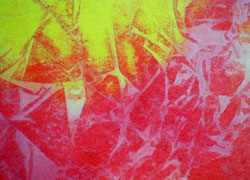

Watercolor Lesson - Monoprinting - Texturing With Plastic Wrap.
MATERIALS LIST
Hover Or Click
A Color For Information
Burnt Sienna
A sedimentary color; sediments quickly offering a mottled or shimmery look to the final (wash)
+ close +Viridian
A sedimentary color; sediments quickly offering a mottled or shimmery look to the final (wash)
+ close +Pthalocyanine Blue
A "warm" (greenish) blue.
A non sedimentary color settles out smoothly yielding a uniform finish (wash)
+ close +Pyrrol Red
A "warm" (orangish) red.
A non sedimentary color settles out smoothly yielding a uniform finish (wash)
+ close +Arylide Yellow FGL
A "warm" (orangish) yellow.
A non sedimentary color settles out smoothly yielding a uniform finish (wash)
There is not an industry standard name for this color. I am offering DaVincis Brand name.
+ close +Yellow Ocher
A sedimentary color.
sediments quickly offering a mottled or shimmery look to the final (wash)
+ close +Cerulean Blue
A sedimentary color.
Sediments quickly offering a mottled or shimmery look to the final (wash)
+ close +Ultramarine Blue
A cool (purplish) blue.
A non sedimentary color settles out smoothly, theoretically yielding a uniform final (wash).
Actually Ultramarine Blue "flocculates" (gathers in clumps) so we only get a fairly smooth (wash)
Sadly, it's the only purplish blue thats light-fast and available to artists.
+ close +Alizarin Crimson
( Quinacridone )
A cool (purplish) red.
A non sedimentary color settles out smoothly yielding a uniform finish (wash)
n fact, Alizarine Crimson (a very early man made pigment) lost favor when it was found non light-fast.
Today we replace it it with a better version of the same color called Quinacdridone Red.
Nevertheless, manufacturers still call it Alizerine Crimson.
+ close +A cool (greenish) yellow
A non sedimentary color settles out smoothly yielding a uniform finish (wash)
There is not an industry standard name for this color. I am offering the DaVincis Brand name.
+ close +
 The concept of printing is that two surfaces come together to interact. In watercolor monoprinting, the paper surface you are working with is affected by another; a textured surface. The way it works in watercolor, is that you first paint a very wet picture. While the painting is still wet , you cover it with something different.
The concept of printing is that two surfaces come together to interact. In watercolor monoprinting, the paper surface you are working with is affected by another; a textured surface. The way it works in watercolor, is that you first paint a very wet picture. While the painting is still wet , you cover it with something different.
The outcome of monoprinting is controlled by the interaction of the paper and the printer. The finished product is predictable as to overall effect. On a smaller scale it is virtually unpredictable.
When you drop a crumpled sheet of plastic wrap onto your wet painting two wonderful things happen:
The flat areas of the plastic are granulated like mad.
The wrinkles leave all sorts of special effects.
This is something you want to try. You should try it several different ways with different colors.
A start, is a partially painted picture, which you then overpaint to create something unusual. I treat monoprints as starts. So do many other watercolor artists.
Watercolor Painting Tutorials Watercolor Materials

A Wet In Wet Watercolor Painting Lesson.

How To Create Depth In A Painting.

Painting A Basket - A Lesson Lifting Watercolor Paint - Part 1.

Filling The Basket - A Lesson In Painting Objects Part 2.

Watercolor Lesson - Monoprinting - Texturing With Plastic Wrap.

Landscape Shadows. A Demonstration

Color For Beginners - How to mix all the colors.

Color schemes - How to plan the colors of a painting.

How to paint emotions using warm and co

Abstract Art - A discussion.